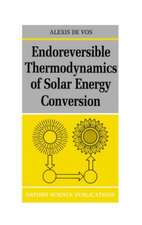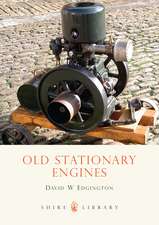Modelling, Monitoring and Diagnostic Techniques for Fluid Power Systems
Autor John Wattonen Limba Engleză Paperback – 13 oct 2010
This comprehensive reference gives the first integrated exposition of the fluid power applications of many of the techniques it describes: time-encoded signal processing; artificial neural networks and expert systems among others. Advantages and limitations of the paths are presented reminding the reader to consider the gamut of methods leading to positive decision-making regarding fault diagnosis. Four parts combine to produce an all-embracing whole:
• an introduction to component behaviour;
• a guide to the modelling methods employed for circuit analysis;
• methods of condition monitoring;
• common faults and breakdowns.
| Toate formatele și edițiile | Preț | Express |
|---|---|---|
| Paperback (1) | 700.75 lei 6-8 săpt. | |
| SPRINGER LONDON – 13 oct 2010 | 700.75 lei 6-8 săpt. | |
| Hardback (1) | 956.18 lei 6-8 săpt. | |
| SPRINGER LONDON – 15 feb 2007 | 956.18 lei 6-8 săpt. |
Preț: 700.75 lei
Preț vechi: 824.41 lei
-15% Nou
Puncte Express: 1051
Preț estimativ în valută:
134.13€ • 145.75$ • 112.74£
134.13€ • 145.75$ • 112.74£
Carte tipărită la comandă
Livrare economică 22 aprilie-06 mai
Preluare comenzi: 021 569.72.76
Specificații
ISBN-13: 9781849965910
ISBN-10: 1849965919
Pagini: 376
Ilustrații: XIV, 360 p. 268 illus.
Dimensiuni: 155 x 235 x 20 mm
Greutate: 0.53 kg
Ediția:Softcover reprint of hardcover 1st ed. 2007
Editura: SPRINGER LONDON
Colecția Springer
Locul publicării:London, United Kingdom
ISBN-10: 1849965919
Pagini: 376
Ilustrații: XIV, 360 p. 268 illus.
Dimensiuni: 155 x 235 x 20 mm
Greutate: 0.53 kg
Ediția:Softcover reprint of hardcover 1st ed. 2007
Editura: SPRINGER LONDON
Colecția Springer
Locul publicării:London, United Kingdom
Public țintă
Professional/practitionerCuprins
Modelling and Computer Simulation as an Aid to Understanding Circuit Behaviour.- Condition Monitoring Methods.- Common Faults and Breakdowns that can occur in a Hydraulic Circuit.
Notă biografică
Professor Watton started his career in industry as a Senior Systems Engineer working on the electrohydraulic control and steering dynamics of automated pipe-laying machines. Following a period at Huddersfield University, he returned to Cardiff as a Lecturer in Mechanical Engineering in 1979.
Since 1969, research work has been continually directed towards fluid power control and, latterly, condition monitoring. He gained his D.Sc. in 1996 and in 1999 was awarded the IMechE Bramah Medal for "outstanding research contributions to fluid power". Professor Watton is a Chartered Engineer and a Fellow of the Institution of Mechanical Engineers.
Professor Watton has taken a broad approach to the study of fluid power control, covering topics such as component design, systems simulation and CAD, fluid mechanics and the application of LDA/CFD techniques, control techniques, condition monitoring and dault diagnosis, the applications AI to modelling/adaptive control/fault classification, special applications such as high-water-content systems. He has been involved as co-designer on two novel mobile machines for general loader/agricultural/forestry applications, and the Soil Nailing machine for civil engineering applications; both machines are in commercial operation. The work on condition monitoring and fault diagnosis and, in particular, the application of on-line computer-based techniques has led to pioneering applications in the steel processing industry. He has published over 160 papers and 3 books and ahs supervised many M.Sc. and Ph.D. students over the past 20 years, including Eng.D. students with Corus plc since 1992. He does consultancy work with fluid power companies and has been active as an expert witness for several international companies over the past 10 years. Professor Watton teaches control theory, condition monitoring, fluid power, vibrations and dynamics at undergraduate level.
Since 1969, research work has been continually directed towards fluid power control and, latterly, condition monitoring. He gained his D.Sc. in 1996 and in 1999 was awarded the IMechE Bramah Medal for "outstanding research contributions to fluid power". Professor Watton is a Chartered Engineer and a Fellow of the Institution of Mechanical Engineers.
Professor Watton has taken a broad approach to the study of fluid power control, covering topics such as component design, systems simulation and CAD, fluid mechanics and the application of LDA/CFD techniques, control techniques, condition monitoring and dault diagnosis, the applications AI to modelling/adaptive control/fault classification, special applications such as high-water-content systems. He has been involved as co-designer on two novel mobile machines for general loader/agricultural/forestry applications, and the Soil Nailing machine for civil engineering applications; both machines are in commercial operation. The work on condition monitoring and fault diagnosis and, in particular, the application of on-line computer-based techniques has led to pioneering applications in the steel processing industry. He has published over 160 papers and 3 books and ahs supervised many M.Sc. and Ph.D. students over the past 20 years, including Eng.D. students with Corus plc since 1992. He does consultancy work with fluid power companies and has been active as an expert witness for several international companies over the past 10 years. Professor Watton teaches control theory, condition monitoring, fluid power, vibrations and dynamics at undergraduate level.
Textul de pe ultima copertă
Today, fluid power systems, hydraulic and pneumatic, in alliance with advanced electronics, provide the world with an unprecedented array of applications and systems from heavy-lifting equipment to spray painting, injection moulding, motion control and product assembly. In common with other facets of modern industrial operation, fluid power systems must be examined with a view to obtaining:
• the highest product quality;
• optimised efficiency;
• improved safety;
• maximum profitability.
Modelling, Monitoring and Diagnostic Techniques for Fluid Power Systems covers the background theory of fluid power and indicates the range of concepts necessary for a modern approach to condition monitoring and fault diagnosis in a readable and understandable fashion. The theory is constantly leavened by 15 years' worth of practical measurements by the author, working in association with major fluid power companies, and real industrial case studies – hot-strip-mill monitoring in conjunction with Corus p.l.c. being just one example. Comprising four parts, it provides:
• an introduction to component behaviour;
• a guide to the modelling methods employed for circuit analysis;
• methods for doing condition monitoring;
• common faults and breakdowns.
Modelling, Monitoring and Diagnostic Techniques for Fluid Power Systems gives the first integrated exposition of the fluid power applications of many of the techniques it describes: time-encoded signal processing; artificial neural networks and expert systems among others. Advantages and limitations of the different paths are presented to emphasise that the reader should consider the gamut of methods leading to positive decision-making regarding fault diagnosis.
The comprehensive reference for its subject, this book tells practising fluid power engineers all they need to know about keeping track of the "health" oftheir equipment, processes and products. With nearly four hundred references to provide a good overview of the subject and to stimulate further research, this reference will also be invaluable to graduate and senior undergraduate students entering the field.
• the highest product quality;
• optimised efficiency;
• improved safety;
• maximum profitability.
Modelling, Monitoring and Diagnostic Techniques for Fluid Power Systems covers the background theory of fluid power and indicates the range of concepts necessary for a modern approach to condition monitoring and fault diagnosis in a readable and understandable fashion. The theory is constantly leavened by 15 years' worth of practical measurements by the author, working in association with major fluid power companies, and real industrial case studies – hot-strip-mill monitoring in conjunction with Corus p.l.c. being just one example. Comprising four parts, it provides:
• an introduction to component behaviour;
• a guide to the modelling methods employed for circuit analysis;
• methods for doing condition monitoring;
• common faults and breakdowns.
Modelling, Monitoring and Diagnostic Techniques for Fluid Power Systems gives the first integrated exposition of the fluid power applications of many of the techniques it describes: time-encoded signal processing; artificial neural networks and expert systems among others. Advantages and limitations of the different paths are presented to emphasise that the reader should consider the gamut of methods leading to positive decision-making regarding fault diagnosis.
The comprehensive reference for its subject, this book tells practising fluid power engineers all they need to know about keeping track of the "health" oftheir equipment, processes and products. With nearly four hundred references to provide a good overview of the subject and to stimulate further research, this reference will also be invaluable to graduate and senior undergraduate students entering the field.
Caracteristici
Heavily supported with examples drawn from real industrial plant – the methods in this book have been shown to work Provides the practising engineer with methods that will maximise profit and safety while minimising down-time and repair Points out to the student things that commonly go wrong with fluid power systems and tested ways of avoiding them Comprehensive guide to condition monitoring of fluid power systems giving sound practical advice as well as necessary theory Includes supplementary material: sn.pub/extras











